Socket overview of LED lamps and lamp sockets
 LED illuminants are available in an enormous range for a large number of possible applications. As a layman, you can sometimes lose track of things. Since the LED light source is contnuing its triumphant advance, it is simply good and reassuring to know which light source is the right one for your own lamp socket in each specific case. We are therefore happy to provide you with an illustrated overview of the various socket types. This makes it easier to choose the right light source. For the sake of completeness, we have included a few socket types without pictures in the list, although we do not carry them.
LED illuminants are available in an enormous range for a large number of possible applications. As a layman, you can sometimes lose track of things. Since the LED light source is contnuing its triumphant advance, it is simply good and reassuring to know which light source is the right one for your own lamp socket in each specific case. We are therefore happy to provide you with an illustrated overview of the various socket types. This makes it easier to choose the right light source. For the sake of completeness, we have included a few socket types without pictures in the list, although we do not carry them.

Socket E27
The E27 screw thread is one of the well-known sockets from the time of conventional light bulbs. The E27 socket is the classic “light bulb thread”. This designation simply comes from the fact that the screw base has an outer diameter of 27 mm. The E stands for Edison, the inventor of the light bulb. Replacing the dying incandescent lamp in this case is extremely simple. The LED E27 energy savers can simply be exchanged for the incandescent lamp. This happens seamlessly and without any conversion.

Socket E14
The E14 version is similar to the E27 version. It is colloquially called “candle holder”. This is because this socket size is very commonly used in chandeliers etc. Similar to the E27 socket, the E14 socket gets its name from the diameter of the screw thread and its inventor Edison. The E14 LEDs are also used in wall lamps or desk lamps and even in Christmas lights. By replacing conventional light sources with energy-saving E14 LED lamps, you can save a lot of electricity and money over the year. The change can also be made seamlessly with the E14 and without conversion.

Socket GU5.3 – type MR16
Low-voltage halogen spotlights with 12 volts usually have a GU5.3 base (5.3mm spacing between the pin bases) and the MR16 design. MR16 describes the design for a radiator with a diameter of usually 50 mm. The GU5.3 MR16 halogen spotlights must be operated with a transformer and can be used in a variety of ways, e.g. in the living room, bedroom or children’s room. A conversion to inexpensive GU5.3 MR16 LED spotlights makes economic and ecological sense, as electricity savings of up to 90% is possible. However, when replacing, attention must be paid to the existing transformer. We generally recommend using a special LED transformer when installing low-voltage LED lamps.
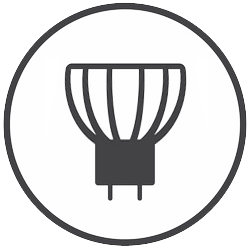
Base GU5.3 – type MR11
In addition to the MR16 design, the GU5.3 socket also has the MR11 design. The difference is small but significant. It is about the diameter of the halogen spotlight, which is only 35mm. This is why the GU5.3 MR11 bulbs can also be found in rather filigree fixtures such as bar and counter lighting or mobile homes and caravans. It makes sense to switch to GU5.3 MR11 LED spots here, as the battery is used less.
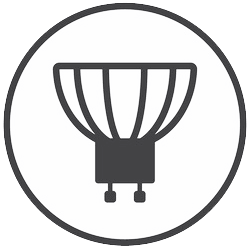
Socket GU10
The GU10 base does not have much in common with the E14 and E27 sockets in terms of its structure and function. It is also known as a bayonet socket or bayonet lock. The striking thing about this socket is the 10mm gap between the two socket pins. The GU10 bulb comes into the right position by plugging in and turning. There are mostly ceiling lights in which the GU10 base is used. In the course of further development, however, the GU10 halogen spotlights can be seen more often today. The power saving is an impressive 90%. As a rule, these GU10 emitters usually have a diameter of 50mm. The emitters of the ES111 design have a corresponding diameter of 111mm.
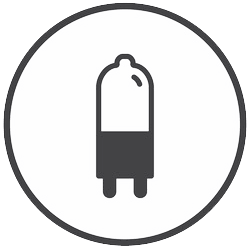
Socket GU9
The G9 socket is also known as the GU9 socket. The G9 halogen spotlights have loop-shaped high-voltage socket pins that are incorporated into the glass socket. This is conspicuous insofar as the G9 LED spotlights mostly have solid, filled-in plastic pins. The exchange is not a problem because you can easily swap the G9 halogen spotlights for the new generation G9 LED spotlights. However, attention must be paid to the diameter, as space is quite limited for most G9 lamps. The two connection pins of the G9 / GU9 lamps have a distance of 9mm. They are designed to work at a voltage of 220V. These bulbs are mainly used in ceiling lights, wall lights and table and hanging lamps.
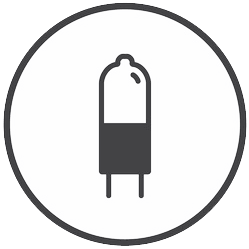
Socket G4 / GU4
The bulbs of the G4 and GU4 sockets have a pin spacing of 4mm. The difference between the G4 base and the GU4 base only concerns the diameter of the base pins. With a diameter of 0.95-1.05 mm, the GU4 is slightly larger than the G4 bulbs, which have a diameter of 0.65-0.75 mm.
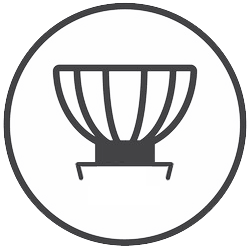
Socket G53 – type AR111
The G53 base accepts halogen spotlights as plug-in bases. The two contact parts have a distance of 53mm. The G53 AR111 reflector lamps are popular and widely used. However, they have a high energy requirement. The power saver G53 AR111 LED spotlight is available as a replacement.
Socket GX53
The GX53 socket is in its bayonet mount ? Architecture very similar to the GU10 base. However, it differs in the distance between the connections. Here it is 53mm. The matching GX53 LED spotlights are inserted in the bayonet lock by inserting and screwing into the socket. They can be found in many base strips, recessed floor spotlights and ceiling lights.
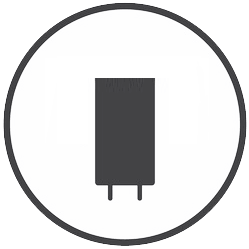
Socket T8 / G13
The socket T8 G13 accepts tubes with a diameter of almost 26mm and a pin spacing of 13mm. This classic is extremely widespread and can be found almost everywhere. However, even in this case, switching to SMD LED tubes saves electricity costs twice as much. In addition to the pure electricity savings of the fluorescent tube, the ballast can also be dispensed with by exchanging it? which then also consumes no more electricity.
Socket T5 / G5
The tube socket T5 G5 takes tubes with a diameter of 5/8 inch = approx. 16mm. The two pins of the tube are 5mm apart.

Design PAR spotlight
PAR spotlights usually have a classic E27 screw thread. However, it is available in different versions. The main difference is their different diameters. Common are PAR 16 (Ø 50.8mm), PAR 20 (Ø 63.5mm), PAR 30 (Ø 95.2mm), PAR 36 (Ø 114.3mm), PAR 38 (Ø 120.6mm), PAR 56 (Ø 177.8mm) and PAR 64 (Ø 203.2mm). These PAR spotlights are used in event technology. You can see them hanging as so-called 4 or 6 bars.) They are also used for shop lighting and for general lighting in private households. In contrast to the classic PAR halogen spotlights, PAR LED spotlights have the clear advantage of lower power consumption
Type ES111
The ES111 spotlights usually have a GU10 base. But they are also available as S111 spotlights with E27 screw thread. These bulbs got their name from their diameter of 111 millimeters. These ES111 GU10 LED spotlights are often used in ceiling spotlights, recessed ceiling lights and spotlights (also in the private sector).
Socket G24d-1 / G24d-2 / G24d-3 / G24q-1 / G24q-2 / G24q-3
The bulbs with G24 sockets must be clearly differentiated. It is about the number of connector pins. In this case, with 2 pins one speaks of the socket G24d (d stands for DUO). Four pins are called Quattro, which is why they are G24q lamps (q stands for Quattro). In this socket family, however, a distinction is made between three other variants. These can be recognized by the code letter – the 2-pin variant G24d is available as G24d-1 / G24d-2 / G24d-3 The 4-pin variant G24q is available as G24q-1 / G24q-2 / G24q-3.
The additional number at the end tells you where the small insertion pin is located. At the last digit G24d-1 it is in the middle. The last digit G24d-2 stands for left and analogously the G24d-3 stands for the right position. This type series can be found in shop lighting, petrol station lighting, shelf lighting and ceiling lighting.
There are the G24d LED lamps with a universal base. This makes them universally applicable for G24d-1, G24d-2 and G24d-3 sockets. These lamps can be operated both with and without a ballast.
If you would like to exchange G24q lamps for the more economical G24 LED lamps, this is no problem. All you have to do is remove the ballast. In any case, an electrician should be asked to do this. Flashlight R7s
R7s
The R7s flashlights are available in 3 different lengths: 78mm, 118mm and 189mm. The high-consumption R7s halogen lamps are mostly found in uplighters in living rooms; but occasionally also in various spotlights outdoors, for example for parking lot lighting.
This is where the more economical R7s LED flashlight can save a lot of electricity. The only downside is the fact that the R7s LED flashlights are limited in terms of brightness. The reason for this lies in the fact that there is hardly any space for adequate cooling of the electronics in the tightly dimensioned designs. Socket 2G7
The 2G7 socket is at home in energy-saving lamps and compact fluorescent lamps. The socket has 4 pins that are attached in a row with a spacing of 7mm one behind the other.
Socket 2G11
The lamp base 2G11 is similar to the 2G7 base. There are also 4 connection pins in a row. Compared to the 2G7 socket, however, with a pin spacing of 11mm.
Socket G23
The socket G23 has 2 connection pins with a distance of 23mm. When replacing such a lamp, the starter (igniter) must always be replaced as well.
Socket E40
The E40 socket is, so to speak, the big brother of the widespread E27 screw thread. This socket can be found wherever a very high level of brightness is required. In this case, it is not the living room, but rather street lighting, hall spotlights, etc.
 LED illuminants are available in an enormous range for a large number of possible applications. As a layman, you can sometimes lose track of things. Since the LED light source is contnuing its triumphant advance, it is simply good and reassuring to know which light source is the right one for your own lamp socket in each specific case. We are therefore happy to provide you with an illustrated overview of the various socket types. This makes it easier to choose the right light source. For the sake of completeness, we have included a few socket types without pictures in the list, although we do not carry them.
LED illuminants are available in an enormous range for a large number of possible applications. As a layman, you can sometimes lose track of things. Since the LED light source is contnuing its triumphant advance, it is simply good and reassuring to know which light source is the right one for your own lamp socket in each specific case. We are therefore happy to provide you with an illustrated overview of the various socket types. This makes it easier to choose the right light source. For the sake of completeness, we have included a few socket types without pictures in the list, although we do not carry them.










